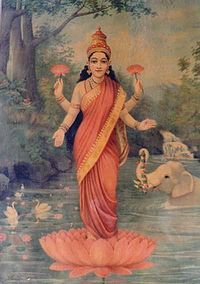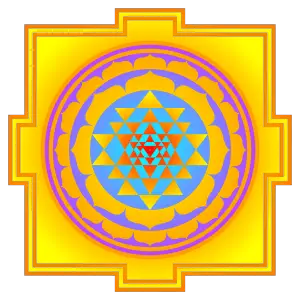Difference between revisions of "Shakti" - New World Encyclopedia
Scott Dunbar (talk | contribs) (Imported and credited article from Wikipedia, plus removed unneeded links.) |
Scott Dunbar (talk | contribs) m (→Shakti Peeths) |
||
| Line 1: | Line 1: | ||
{{Started}}{{Claimed}} | {{Started}}{{Claimed}} | ||
| − | + | [[Image:SriYantra construct.svg|thumb|The [[Sri Yantra]].]] | |
| − | |||
| − | [[Image: | ||
'''Shakti''' meaning ''force'', ''power'' or ''energy'' is the [[Hinduism|Hindu]] concept or personification of [[God]]'s [[female]] aspect, sometimes referred to as 'The Divine Mother'. Shakti represents the active, dynamic principles of feminine power. In [[Shaktism]], Shakti is | '''Shakti''' meaning ''force'', ''power'' or ''energy'' is the [[Hinduism|Hindu]] concept or personification of [[God]]'s [[female]] aspect, sometimes referred to as 'The Divine Mother'. Shakti represents the active, dynamic principles of feminine power. In [[Shaktism]], Shakti is | ||
worshiped as the [[Supreme Being]], however, in other Hindu traditions, Shakti embodies the active energy and power of male [[deity|deities]] ([[Purusha]]s), such as [[Vishnu]] in [[Vaishnavism]] or [[Shiva]] in [[Shaivism]]. Vishnu's shakti counterpart is called [[Lakshmi]], with [[Parvati]] being the female shakti of Shiva. | worshiped as the [[Supreme Being]], however, in other Hindu traditions, Shakti embodies the active energy and power of male [[deity|deities]] ([[Purusha]]s), such as [[Vishnu]] in [[Vaishnavism]] or [[Shiva]] in [[Shaivism]]. Vishnu's shakti counterpart is called [[Lakshmi]], with [[Parvati]] being the female shakti of Shiva. | ||
== Mythology == | == Mythology == | ||
| + | [[Image:Ravi Varma-Lakshmi.jpg|thumb|200px|right||[[Lakshmi]] is a common aspect of Shakti]] | ||
In the Hindu [[scripture]] '[[Devi Mahatmya]]', [[Mahamaya]] (Great Maya) is said to cover Vishnu's eyes in ''[[Yoga Nidra|Yoganidra]]'' (divine sleep) during cycles of existence when all is resolved into one. By exhorting Mahamaya to release Her illusory hold on Vishnu, [[Brahma]] is able to bring Vishnu to aid him in killing two [[rakshasha|demon]]s, [[Madhu]] and [[Kaitabh]], who have manifested from Vishnu's sleeping form. | In the Hindu [[scripture]] '[[Devi Mahatmya]]', [[Mahamaya]] (Great Maya) is said to cover Vishnu's eyes in ''[[Yoga Nidra|Yoganidra]]'' (divine sleep) during cycles of existence when all is resolved into one. By exhorting Mahamaya to release Her illusory hold on Vishnu, [[Brahma]] is able to bring Vishnu to aid him in killing two [[rakshasha|demon]]s, [[Madhu]] and [[Kaitabh]], who have manifested from Vishnu's sleeping form. | ||
The Shakti goddess is also known as Amma (meaning 'mother') in south India, especially in the states of Tamil Nadu,Kerala and Andhra Pradesh. There are many temples devoted to various incarnations of the Shakti goddess in most of the villages in [[South India]]. The rural people believe that Shakti is the protector of the village, the punisher of evil people, the curer of diseases, and the one who gives welfare to the village. They celebrate Shakti Jataras with a lot of hue and great interest once a year. Some examples of incarnations are Gangamma, Aarti, Kamakshamma, Kanakadurga, Mahalakshmammma, Meeenakshamma, Poleramma and Perantalamma. | The Shakti goddess is also known as Amma (meaning 'mother') in south India, especially in the states of Tamil Nadu,Kerala and Andhra Pradesh. There are many temples devoted to various incarnations of the Shakti goddess in most of the villages in [[South India]]. The rural people believe that Shakti is the protector of the village, the punisher of evil people, the curer of diseases, and the one who gives welfare to the village. They celebrate Shakti Jataras with a lot of hue and great interest once a year. Some examples of incarnations are Gangamma, Aarti, Kamakshamma, Kanakadurga, Mahalakshmammma, Meeenakshamma, Poleramma and Perantalamma. | ||
| − | ==Shakti | + | ==Shakti Peethas== |
| − | There are 51 important centres of Shakti worship located in the Indian sub-continent, which are located in [[India]], [[Sri Lanka]], [[Nepal]], [[Bangladesh]], [[Tibet]] and even [[Pakistan]]. These are called | + | There are 51 important centres of Shakti worship located in the Indian sub-continent, which are located in [[India]], [[Sri Lanka]], [[Nepal]], [[Bangladesh]], [[Tibet]] and even [[Pakistan]]. These are called Shakti Peethas. |
| − | |||
==References== | ==References== | ||
Revision as of 06:43, 10 August 2007
Shakti meaning force, power or energy is the Hindu concept or personification of God's female aspect, sometimes referred to as 'The Divine Mother'. Shakti represents the active, dynamic principles of feminine power. In Shaktism, Shakti is worshiped as the Supreme Being, however, in other Hindu traditions, Shakti embodies the active energy and power of male deities (Purushas), such as Vishnu in Vaishnavism or Shiva in Shaivism. Vishnu's shakti counterpart is called Lakshmi, with Parvati being the female shakti of Shiva.
Mythology

In the Hindu scripture 'Devi Mahatmya', Mahamaya (Great Maya) is said to cover Vishnu's eyes in Yoganidra (divine sleep) during cycles of existence when all is resolved into one. By exhorting Mahamaya to release Her illusory hold on Vishnu, Brahma is able to bring Vishnu to aid him in killing two demons, Madhu and Kaitabh, who have manifested from Vishnu's sleeping form.
The Shakti goddess is also known as Amma (meaning 'mother') in south India, especially in the states of Tamil Nadu,Kerala and Andhra Pradesh. There are many temples devoted to various incarnations of the Shakti goddess in most of the villages in South India. The rural people believe that Shakti is the protector of the village, the punisher of evil people, the curer of diseases, and the one who gives welfare to the village. They celebrate Shakti Jataras with a lot of hue and great interest once a year. Some examples of incarnations are Gangamma, Aarti, Kamakshamma, Kanakadurga, Mahalakshmammma, Meeenakshamma, Poleramma and Perantalamma.
Shakti Peethas
There are 51 important centres of Shakti worship located in the Indian sub-continent, which are located in India, Sri Lanka, Nepal, Bangladesh, Tibet and even Pakistan. These are called Shakti Peethas.
ReferencesISBN links support NWE through referral fees
External links
- Indian Mythology: Shakti
- A site containing short biographies of several Shakta devotees from the Indian state of Bengal
- Shakti: Listing of usage in Puranic literature
- Shakti temples of India (Includes articles on Shaktism)
Credits
New World Encyclopedia writers and editors rewrote and completed the Wikipedia article in accordance with New World Encyclopedia standards. This article abides by terms of the Creative Commons CC-by-sa 3.0 License (CC-by-sa), which may be used and disseminated with proper attribution. Credit is due under the terms of this license that can reference both the New World Encyclopedia contributors and the selfless volunteer contributors of the Wikimedia Foundation. To cite this article click here for a list of acceptable citing formats.The history of earlier contributions by wikipedians is accessible to researchers here:
The history of this article since it was imported to New World Encyclopedia:
Note: Some restrictions may apply to use of individual images which are separately licensed.
